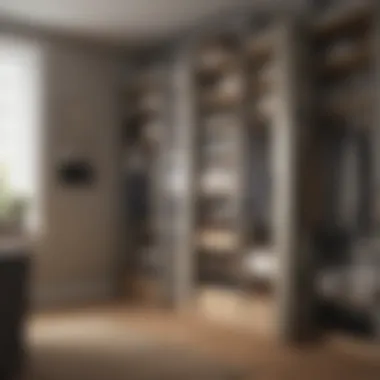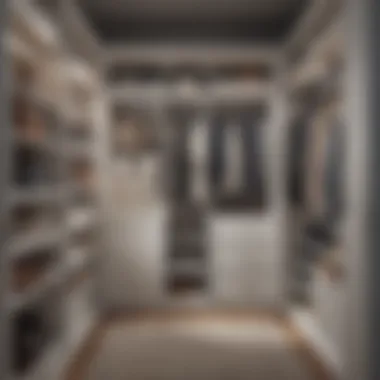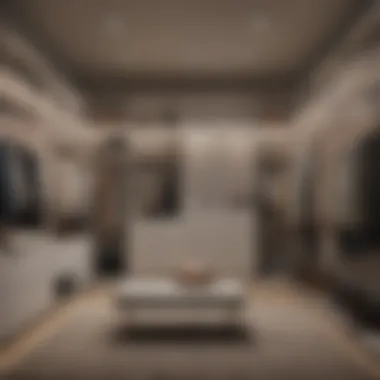Maximize Your Closet Space with Innovative Solutions


Intro
As urban living spaces shrink, finding ways to maximize closet space becomes essential. A well-organized closet not only streamlines daily routines but also contributes positively to one’s mental space. Clutter affects well-being, making it crucial to embrace effective storage solutions. This article covers methods for decluttering, optimizing organization systems, and upgrading hardware.
Additionally, the discussion includes closet design trends that align with modern aesthetics. By combining innovative storage solutions with an understanding of organization, readers gain practical knowledge to enhance both functionality and aesthetic appeal.
Home Features
Architectural Styles
The architectural style of a home can significantly influence the design and function of closets. For instance, contemporary homes often prioritize minimalistic designs that incorporate built-in storage. Tall ceilings in newer builds allow for vertical storage solutions that can help maximize space. Meanwhile, older homes may feature small or awkwardly shaped closets. Understanding these features is critical when planning a closet overhaul.
Interior Design Trends
Closet design is no longer merely functional; it is also part of the home’s aesthetic. Current trends include:
- Open shelving: This allows for visual access to items and creates a sense of spaciousness.
- Color-coordinated storage: Using similar colors for bins and baskets can contribute to an organized look.
- Integrated lighting: LED lighting in closets can enhance visibility while also displaying items attractively.
To reflect personal style, consider custom solutions that adapt to user needs. Investing in good design can elevate the closet from a storage area to a well-organized sanctuary.
"Effective storage solutions can turn a chaotic space into one of harmony and calm."
Innovative Strategies for Decluttering
Implementing effective decluttering strategies can be liberating. Here are a few methods:
- The One-Year Rule: If an item hasn’t been used in a year, consider letting it go.
- Seasonal Refresh: Regularly assess your wardrobe to adapt to changing seasons. Rotate items that you use less frequently.
- Digital Inventory: Take photos of clothing or shoes that you rarely use. This helps you keep track without needing to maintain clutter.
Adopting a routine for decluttering transforms a daunting task into manageable steps, potentially providing motivation to tackle a cluttered closet.
Closure
Maximizing closet space is interconnected with overall home organization and mental clarity. Through architectural awareness, adherence to design trends, and innovative decluttering strategies, one can create a space that serves both functional and aesthetic purposes. As you read further in this article, you will discover how innovative solutions not only enhance functionality but also resonate with current design sensibilities. This careful attention to detail brings personal satisfaction and elevates the overall experience of your home.
The Need for More Closet Space
In contemporary living, the demand for efficient organization is significant. As homes become smaller, the concept of maximizing closet space takes on greater importance. Many people overlook their closets as underutilized areas. However, they serve not just as storage but as integral components of an orderly home. Lack of adequate closet space contributes to clutter, making it harder to find necessary items. This creates frustration and may even lead to poor decisions regarding purchasing new things, often making the clutter worse.
Identifying the need for more closet space is about more than just aesthetics. It also relates to overall functionality. Effective storage solutions can enhance daily routines. Consider how easy it is to access seasonal clothing or locate important documents when there is a well-organized space. Maximizing space allows individuals to enjoy their belongings without chaos.
Understanding the Clutter Problem
Clutter is not merely an eyesore; it can affect one's mental state. Often, it becomes overwhelming to face a disorganized closet. Many individuals may find it challenging to determine what to keep and what to discard. This analysis paralysis prevents effective decision-making. As such, understanding how clutter accumulates is the first step towards resolution.
Common reasons include:
- Accumulation of items over time
- Emotional attachments to possessions
- Lack of time dedicated to organization
It is essential to recognize these patterns. An acknowledgment of the clutter problem can motivate the necessary actions to address the situation.
Impacts of Limited Storage on Daily Life
Limited closet space does not just affect physical environments; it extends to overall life quality. It is linked to increased stress and anxiety levels. When a person has difficulty finding what they need, their daily efficiency is hampered. Even small tasks can become difficult.
Additionally, clutter impacts:
- Time Management: The time spent seeking items can disrupt schedules.
- Mental Clarity: A chaotic environment makes it harder to focus.
- Social Interactions: People may feel embarrassed about the state of their space, impacting social gatherings.
The importance of organized storage cannot be overstated. Maximizing closet space is essential not just for aesthetics but for overall well-being. With deliberate strategies, individuals can reclaim time and enhance their quality of life.


"An organized closet is a key to an organized life."
Efforts made to understand and tackle the clutter problem can increase both functionality and satisfaction in daily life.
Assessing Your Current Closet Capacity
Understanding the size and functioning of your current closet is essential in maximizing storage potential. Before implementing any storage solutions, a thorough assessment of your closet's capacity can reveal untapped areas for improvement. This process not only helps in identifying what you own but also highlights the layout that may need rethinking. Several benefits arise from this evaluation. First, it lays the groundwork for effective decluttering. Without knowing what is actually present in your space, it's difficult to make informed decisions about what stays and what goes. Likewise, recognizing the limitations of your current design allows for strategic adjustments that enhance functionality.
Inventory: What You Own
A comprehensive inventory of your closet contents is a vital starting point. Listing out items can foster awareness of what you truly need and what can be let go. Categorizing belongings, whether by season, frequency of use or type, aids in visualizing your overall closet load. You might discover that certain items are rarely used or duplicates exist, which may help in your decluttering efforts.
- Clothing Types: Categorize clothes by type such as tops, pants, and outerwear. This allows for easy identification of surplus items.
- Frequency of Use: Separate items into every day, occasional, and rarely used. This helps prioritize what should be accessible.
- Condition Status: Consider the wear and tear of each item. Items in poor condition may need to be discarded.
This method not only reduces excess but also informs the next stages of organization, ensuring only necessary items fill your closet.
Evaluating Closet Layout and Design
A physical evaluation of your closet layout is equally as important as inventorying contents. This involves examining both the structure and arrangement to maximize usable space. Visual aspects include understanding how items are stored and accessed. Proper layout can transform even small sections into functional areas that work for your lifestyle.
Measurement Techniques
Accurate measurement techniques are fundamental in assessing your closet space. Knowing the precise dimensions allows you to understand volume and plan reorganizing efforts more effectively. Using a tape measure is a simple yet effective approach. It can reveal opportunities such as vertical space that might be underutilized.
- Wall Space: Measure the height and width of walls to explore options like shelving or hanging systems.
- Depth Measurements: Analyzing the depth of the closet can help in determining if deeper storage solutions are necessary.
Understanding space limitations is helpful. However, it is important to recognize that substantial modifications to a closet often require creativity and adaptability.
Identifying Problematic Areas
Identifying problematic areas is crucial in achieving a greater efficiency in your closet. Focus on spots that may hamper easy access or create clutter. These can include overly crowded shelves or poorly placed hooks.
- Accessibility Issues: Look for items that are hard to reach or blocked by other items.
- Underutilized Sections: Sometimes, the lower shelves or top racks can be overlooked but offer great potential for storage solutions.
By addressing these specific areas, you allow optimization of your space in a meaningful way.
"An organized closet reflects an organized mind, promoting clarity and functionality in everyday life."
Decluttering: The First Step to More Space
Decluttering serves as a critical foundation for maximizing closet space. It is not merely about tidying up; it involves assessing what you truly need versus what is just taking up space. This process can yield numerous benefits. Firstly, it allows for a clearer view of the items you own. This visibility leads to better organization and utilization of space. It also contributes to stress reduction. An organized closet can significantly alleviate feelings of anxiety associated with clutter. Additionally, determining what to keep and what to discard fosters a sense of control over one’s environment.
Establishing a Decluttering Timeline
Creating a timeline can be instrumental in managing the decluttering process. A clear plan helps in avoiding procrastination. Begin by designating specific times to tackle different areas of the closet. Breaking it down into manageable chunks can make the task less overwhelming. For example, allocate a weekend to go through clothing and another for shoes and accessories. This approach encourages consistency and gradually transforms your storage space.
Methods for Effective Sort and Purge
Several methods can enhance the effectiveness of sorting through items. Two prominent methods are discussed below:
The Three-Box Method
The Three-Box Method is effective in simplifying the decision-making process during decluttering. The concept involves labeling three boxes: "Keep," "Donate," and "Trash." This method is beneficial as it encourages decisive action regarding each item. One key characteristic of this method is its simplicity, which allows individuals to process items quickly and efficiently. The unique feature of categorizing items helps in reducing indecision, a common hurdle in cluttered environments. An advantage of this method is that it prevents unnecessary back-and-forth, streamlining the decluttering process. However, it also has a disadvantage: if not enforced strictly, it can lead to confusion and mixed decisions about what truly belongs in each category.
Decision-Making Strategies
Effective decision-making strategies are crucial to decluttering success. These strategies can include guidelines on how to assess the value or utility of an item. One key characteristic is prioritizing items based on their emotional or functional significance. Making these decisions considered helps reduce clutter more meaningfully. This method’s unique feature is its focus on personal attachment and frequency of use, providing context for what to keep. Experiences often reveal that this approach fosters a deeper understanding of . An advantage of utilizing decision-making strategies is the potential for long-term organization. However, a drawback could be the emotional difficulty faced when parting with items that hold sentimental value.
Remember, decluttering is about creating a space that serves you better. Being intentional with your decisions leads to a more organized and functional closet.
In summary, decluttering is not just a preliminary step; it is a pivotal process in maximizing closet space. Establishing a timeline and employing sorting methods like the Three-Box Method and effective decision-making strategies can significantly impact the organization of your closet. Understanding the true value of your belongings fosters a clearer, more efficient space, leading to improvements in overall well-being.


Creative Storage Solutions for Maximizing Space
Finding creative storage solutions can dramatically improve the usability of a closet. These innovative methods not only increase available space, but also enhance overall organization, making it easier to find items. As living spaces become more compact, maximizing closet space is very crucial. Employing effective storage solutions can reduce chaos and provide a sense of order.
Vertical Space Utilization
Multi-Tier Hanging Systems
Multi-tier hanging systems allow for efficient use of height in closets. Instead of relying on single rods for hanging clothes, these systems introduce multiple levels for hanging garments. This feature maximizes vertical space, providing room for more items without occupying additional floor area. Popularity stems from their versatility, as they can accommodate various clothing types such as shirts, pants, and dresses.
However, one must consider the accessibility of items. Sometimes, tightly packed layers can make retrieval difficult, which might necessitate reorganizing more frequently compared to traditional rods. Interested users can take measurements to ensure they choose a system that fits comfortably within the closet’s dimensions.
Shelves and Pull-Down Racks
Incorporating shelves and pull-down racks takes advantage of both height and accessibility. Shelves create space for shoes, bags, or folded items, while pull-down racks bring taller sections within reach. This arrangement is particularly suitable for those with limited mobility, helping to make items more accessible.
The adaptability of shelves is significant; they can be repositioned based on changing needs. On the other hand, pull-down racks can sometimes be cumbersome, requiring both strength and coordination to operate efficiently. Hence, the choice between the two must consider the needs and abilities of the user.
Leveraging Furniture for Storage
Under-Bed Storage
Under-bed storage is often overlooked yet incredibly effective for enhancing storage capacity. Utilizing this seldom-used space under beds helps keep items organized and out of sight. Common options include storage bins or drawers that fit under the frame. This approach helps to declutter closets while providing easily accessible space for seasonal clothing or shoes.
The major appeal of this solution is its minimal impact on room aesthetics. However, not all beds offer sufficient clearance, making it essential to measure before investing in storage options. Additionally, regular access to these items can be inconvenient if they become too deeply buried.
Multi-Functional Furniture Pieces
Multi-functional furniture pieces offer dual purposes, combining storage and utility within a single item. For instance, ottomans that serve as seats but can also hide blankets or magazines underneath are excellent. This type of furniture helps to keep spaces tidy while maintaining both style and functionality.
The primary benefit of this solution is its space-saving qualities. However, it may not fit the individual styles of all users. Selecting pieces that complement existing decor while providing the intended utility is crucial to achieving both aesthetic appeal and storage enhancement.
Innovative Organizing Techniques
The concept of innovative organizing techniques is essential for maximizing closet space effectively. Closet organization transcends mere aesthetics; it is about enhancing accessibility and overall functionality. By employing modern methods and tools, one can not only reclaim valuable space but also find a certain peace of mind. Clutter contributes significantly to mental stress, and an organized closet can help mitigate this issue, promoting better emotional well-being.
Use of Clear Bins and Labels
Clear bins serve a dual purpose: they protect items from dust while offering visibility for quick identification. This approach reduces the time spent rummaging through clothes or accessories. Additionally, using bins that vary in size can help cater to specific storage needs. For example, larger bins can hold seasonal clothing, while smaller ones can contain items such as ties or scarves.
Moreover, labels are critical in maintaining the organization. By clearly marking each bin’s contents, you create a user-friendly system. This allows family members or guests to locate items without disrupting the entire space. Adopting a clear labeling system can also aid in future decluttering efforts. When everything is in its designated spot and labeled accordingly, it is easier to identify what can be discarded.
Here are some benefits of using clear bins and labels:
- Visibility: Items are easy to identify at a glance.
- Protection: Prevents clothing and accessories from becoming dusty or damaged.
- Efficiency: Streamlines your daily routine by saving time.
Color-Coding for Quick Access
Color-coding is a psychological strategy that enhances cognitive processing. When items are color-coordinated, it allows for instantaneous recognition and retrieval. Whether organizing clothing or other items, applying a color-coding scheme can make life simpler.
For instance, you can arrange clothing by color within your closet. This not only makes it visually appealing but also allows for quick outfit selection. In addition to clothing, implementing color codes for bins or shelves can provide an additional organizational layer.
To effectively utilize this technique:
- Assign specific colors to certain categories (e.g., casual, formal, seasonal).
- Ensure that the color scheme is consistently applied within the space.
- Use color swatches as a reference if your organizing efforts expand beyond the closet.
By fostering an environment that prioritizes organized techniques, individuals can significantly enhance their organizational systems. Not only does this reflect more efficiency in daily living, but it also conveys a sense of control over one’s personal space.
"An organized closet leads to a simplified life; less time wasted searching leads to more time for what truly matters."


The benefits of innovative organizing techniques are profound. They can positively influence everything from stress levels to time management, making them not just a necessity, but a worthwhile investment in your well-being.
When to Upgrade Your Closet System
In today’s world, maximizing closet space is not just a matter of aesthetics; it is essential for functionality. Knowing when to upgrade your closet system can significantly impact daily life. An effective closet not only secures your belongings but promotes a more organized space. When elements of your closet become inefficient or are not meeting your needs anymore, it may be time for a change.
Identifying Signs of Wear and Inefficiency
Significant wear can be visual or functional. Cramped spaces where you struggle to find items indicate inefficiency. Look for loose hinges, damaged shelves, or sagging rods. These signs suggest that your current setup cannot handle the burden of your belongings. Additionally, if you constantly reorganize without achieving a satisfactory outcome, this is a clear signal.
Changing needs is another factor. Perhaps your lifestyle has evolved but your storage solutions have stayed the same. If your current system cannot accommodate seasonal changes or new clothing items, consider upgrading.
Evaluating Custom Solutions vs. Pre-Made Systems
When thinking about a new closet system, you have the choice between custom solutions and pre-made systems. Each option has its merits and drawbacks, significantly affecting the overall outcome.
Cost Considerations
Cost is often a pivotal point in this decision. Custom solutions generally come with a higher price tag due to tailored measurements and designs. It is essential to assess your budget before making a decision. Pre-made systems can be a more cost-effective alternative. They are readily available and typically cheaper. Comparing the costs can help in deciding what's right for your budget.
Factors such as quality and warranty often come into play. While pre-made systems may seem advantageous for their lower prices, they might not last as long as custom solutions. Consider the longevity of your investment as an essential factor in determining the better option for your needs.
Installation Efforts
Installation efforts also vary between the two choices. Custom solutions often require professional installation, which can add to the overall cost.
This may overwhelm some homeowners who are not prepared for added expenses. On the other hand, many pre-made systems are designed for easy assembly. This allows for a simpler DIY approach, saving both time and costs.
Consider your personal comfort level with installation tasks. If you are handy, a pre-made system may seem appealing. However, if you prefer a stress-free setup, investing in a custom solution may be worth the effort.
Choosing the right closet system is about aligning functionality with personal needs. Each option has its pros and cons, and knowing when to upgrade can significantly enhance your living space.
The Role of Design in Closet Space
Closet design plays a crucial role in maximizing available space and ensuring organization. When closets are well-designed, they can enhance functionality while also contributing to the overall aesthetic of a room. An efficient closet design goes beyond mere storage; it reflects individual style and supports a seamless daily routine. This article will discuss current trends in closet design and the significance of merging aesthetics with functionality in order to create a space that is both practical and visually appealing.
Current Trends in Closet Design
The landscape of closet design is evolving, with several trends emerging that focus on efficiency and accessibility. One noticeable trend is the incorporation of modular systems. Modular designs make it possible for homeowners to customize their closets according to their specific needs. This flexibility allows for greater adaptability over time as storage demands change.
Using mix-and-match shelves and hanging rods enables one to personalize layouts without a major renovation. Furthermore, the move towards incorporating natural materials is also evident. Wood, bamboo, and other organic options not only add warmth but can also contribute to a calming environment.
Innovative lighting solutions have become increasingly popular as well. The use of LED strips or spotlights can illuminate dark corners, making it easier to find items. Additionally, these designs often incorporate mirrored surfaces to enhance light and create the illusion of space.
Integrating Aesthetic Choices with Functionality
Striking a balance between aesthetics and functionality is vital in closet design. A beautiful closet space can boost the owner's enjoyment and encourage a tidy environment. Using color palettes that reflect personal taste can transform a closet into a cohesive part of the home that complements the surrounding decor.
To achieve both functionality and beauty:
- Select high-quality materials that are durable yet visually appealing.
- Incorporate organizational tools such as baskets, bins, and dividers that match the overall design theme while keeping the closet clutter-free.
- Ensure efficient layouts, allowing easy access to frequently used items while showcasing elegant pieces.
A well-thought-out closet design can lead to significant improvements not just in organization, but also in overall mental clarity and emotional well-being.
Psychological Benefits of an Organized Closet
An organized closet transcends mere aesthetics. It significantly impacts our psychological state and overall well-being. When we consider the interplay between space and mental health, we see that clutter often generates feelings of stress and overwhelm. Thus, having a well-organized closet can lead to clarity, reducing anxiety and promoting a sense of control in one's life. Creating an efficient space aligns not only with practical needs but also supports mental and emotional health.
Impact on Stress and Anxiety Levels
Research indicates that a chaotic environment can elevate stress and anxiety. A disorganized closet may lead to feelings of helplessness when searching through items. This emotional burden can accumulate, contributing negatively to one's mental health. Conversely, an organized closet encourages systematic workflows, allowing for smoother daily routines. When everything has its designated place, time spent searching for items diminishes, translating to less frustration and higher productivity.
Additionally, open and clean spaces can provide a soothing visual experience, which is essential in promoting relaxation. A tidy closet reflects care for one’s environment, leading to enhanced feelings of comfort.
"Decluttering and organizing can reduce anxiety and promote emotional well-being."
Cultivating Emotional Well-Being Through Organization
The act of organizing itself can be therapeutic. It offers a chance for introspection and clarity about what belongings are truly valuable. As individuals sort through their possessions, they make conscious decisions, reinforcing personal values and priorities. This reflection helps cultivate a sense of autonomy, enhancing self-esteem.
In addition, the pleasure derived from seeing an organized closet can foster positive emotions. Simple pleasures like feeling accomplished after organizing can lead to an uplifting mood. Furthermore, donating unneeded clothes can invoke feelings of generosity and kindness, contributing to emotional well-being. Sustainable decluttering practices not only renew one's physical space but also nourish the spirit.















